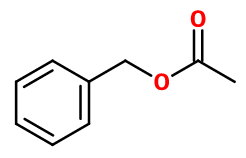
Photo credits: ScenTree SAS
| Company | Ingredient Name | ID | Comments | Naturality | Certifications | MOQ | Purity |
|---|---|---|---|---|---|---|---|
|
|
Acetate de Benzyle - 30 Gr | - |
Visit website
|
- | - | - |
General Presentation
-
CAS N° :
140-11-4 -
EINECS number :
205-399-7 -
FEMA number :
2135 -
FLAVIS number :
09.014
-
JECFA number :
23 -
Volatility :
Head -
Price Range :
€
Physico chemical properties
-
Appearance :
Colorless liquid -
Density :
1,1 -
Refractive Index @20°C :
1,501 - 1,504 -
Optical rotation :
Data not available. -
Vapor pressure :
0,219 hPa @25°C -
Flash Point :
91°C
-
Molecular formula :
C9H10O2 -
Molecular Weight :
150,18 g/mol -
Log P :
1,96 -
Fusion Point :
-51°C -
Boiling Point :
206°C -
Detection Threshold :
2 et 270 ppb (0,000027%)
Chemistry & Uses
Uses in perfumery :
Benzyl acetate is used in floral reconstructions, especially in jasmine, ylang-ylang and monoï notes.
Year of discovery :
Discovered in 1853. Benzyl acetate was first isolated from jasmine absolute during the 10's by german scientists Albert Hesse and Friedrich Müller, because this extract contains 20 to 35% of this molecule.
Natural availability :
Today, natural Benzyl acetate can be extracted from Grandiflorum Jasmine Absolute (and other origins), Ylang-Ylang Extra EO or Narcissus Absolute.
Isomerism :
Para-Cresyl acetate is a constitutional isomer of Benzyl acetate. Both have the same formula, but para-Cresyl acetate is much more animalic and less floral-jasmine than Benzyl acetate.
Synthesis precursor :
Benzyl acetate is not a precursor to the synthesis of another compound of olfactory interest.
Synthesis route :
Nowadays, Benzyl acetate is synthesized by an esterification reaction from acetic acid and Benzyl Alcohol, in the presence of an acid catalyst such as concentrated sulfuric acid.
Stability :
acetates may form acetic acid through time.
Most of the time, the occurrence of a benzenic cycle in a molecule causes a coloration of this molecule through time
Other comments :
Benzyl acetate has a different polarity than Benzylacetone. However, both molecules have a very similar smell. This is the case of several esters, correlated with their analogous ketone.
Regulations & IFRA
Allergens :
This ingredient does not contain any allergen.
IFRA 51th :
This ingredient is not restricted for the 51th amendment

